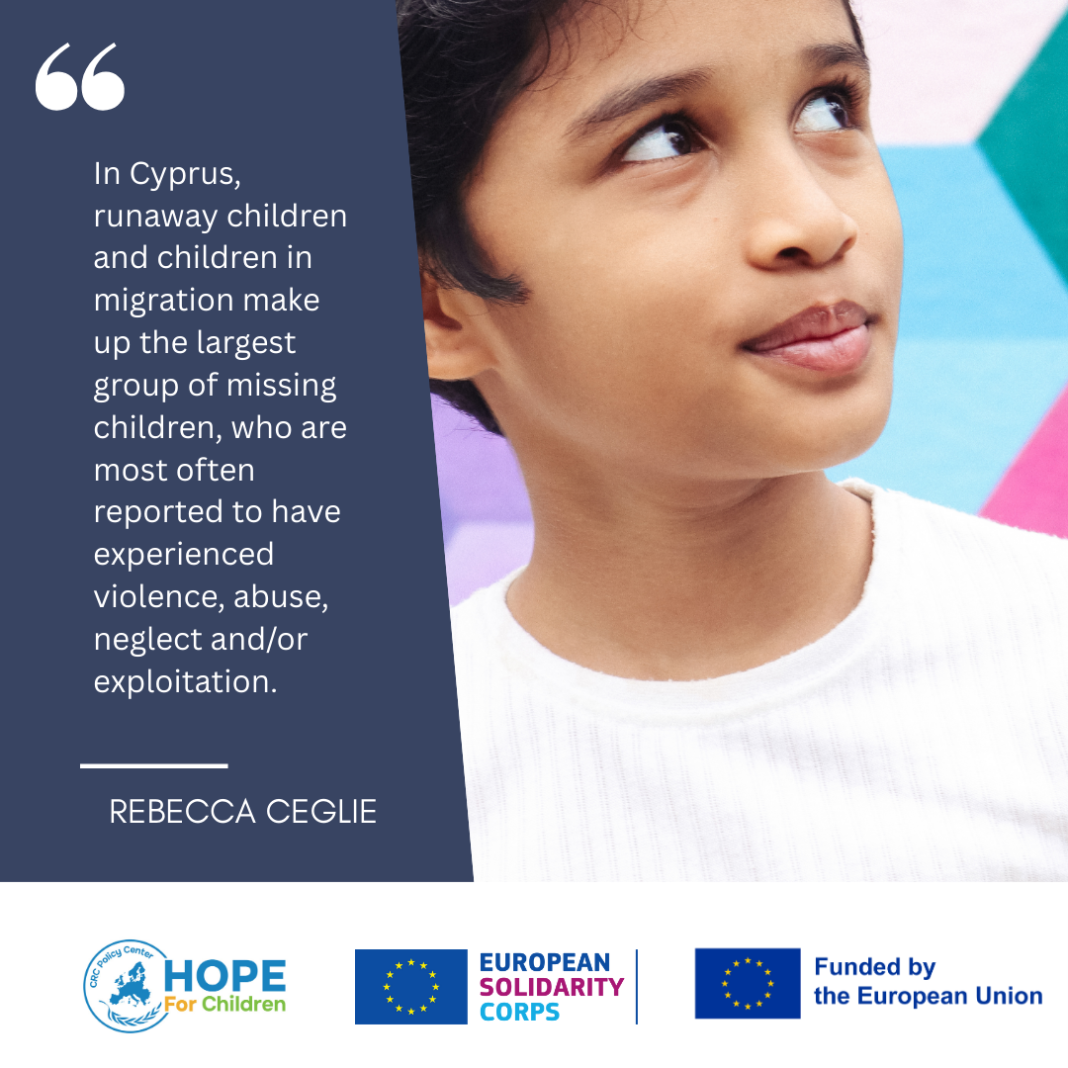Every year, an estimated 250,000 children slip through the net of Europe’s child protection systems and disappear, without a trace, leaving them highly vulnerable to all kinds of dangers. As reported by Missing Children Europe, runaways, children abducted by third parties, victims of international parental abduction, missing children in migration, and children who are lost, injured, or otherwise unaccounted for, represented the main five categories of “missing children”, and the main groups most often exposed to violence or unstable social conditions.
According to the most recent data collected in 2024 across Europe, hotlines reported a total of 6,132 new cases. Of these 4,091 (67%) involved children who had run away. Parental abductions accounted for 1,014 cases (16%), followed by 561 cases (9%) involving lost, injured, or otherwise missing children. Finally, cases involving children in migration slightly increased in 2024, reaching 428 cases (7%) while criminal abduction episodes made up less than 1% of new cases. Especially in Cyprus, the situation regarding missing children presents a complex national challenge and as discovered by Hope For Children’s current DATA MISSING project, runaway children and missing children in migration make up the largest group of missing children, who are most often reported to have experienced violence, abuse, neglect and/or exploitation.
More specifically, most of the reported cases both for runaways and missing migrant children in Cyprus, are unaccompanied children (UAC) of 16-17 years of age, who find ‘alternative solutions’ due to social difficulties and hostile living conditions. In this context, SWS affirmed that runaways have difficulties co-living with peers, Ministry of Justice and Public Order (MJPO) reported that parental abductions usually emerge in the context of mixed marriages. The police shared that a conflicted family environment is a factor that increases the risk of a child going missing. Non-governmental organizations believe that the socioeconomic context is strongly linked to disappearances. As an explanation, it seems that juvenile delinquency is not adequately handled by specialised structures, and the needs of these children are not properly addressed. This increases the likelihood that missing migrant children will escape from care institutions more easily and lose their trace.
Legal Framework and Gaps in Data Collection
Since 2023, changes in the legal-policy frameworks and operational rules and definitions on missing children have been observed at national and European levels, introducing legal acts aimed at regulating the procedures and actions of different actors involved. Several EU legal instruments looked at the specific situation of migrant children, with a view to preventing them from going missing and falling victim to criminal networks. Among them, Article 23 of Asylum Procedures Regulation outlines special guarantees for unaccompanied minors and article 14 of the Trafficking in Human Beings Directive requires Member States to provide specific assistance and support to child victims. Furthermore, through the EU Strategy on the rights of the children, the European Commission urges currently to strength integrated child protection systems in the best interest of the child. This approach aligns with the UN Convention on the Rights of the Child (CRC), which serves as a fundamental framework at the international level, emphasising that all measures concerning a child must ensure the survival, development, protection, and participation of a child.
In Cyprus, missing children cases are officially considered high-risk, and the disappearance of UAC is the most concerning category at the moment, prompting institutional and social actors to take action. Regarding this, the police are the main recipient of the data for missing children, managing a national electronic database in cooperation with local jurisdictions, the Police Crime Investigation Department (Police Order 3/53 of July 2023) and the Office for the Coordination of Missing Persons’ Management. The Social Welfare Services (SWS) collect detailed district-level data and officially forward it to the police, while the MJPO is responsible solely for data related to applications submitted under the scope of the Convention, focused on cases of international parental child abduction. Finally, the SPAVO-HFC Consortium maintains a separate database in which data received directly through the hotline is recorded.
Nonetheless, the situation regarding missing children in Cyprus and more generally in Europe, highlights a series of national gaps ranging from information gathering systems to methods and data sharing with the institutions involved. There are several limitations. First, there is a lack of common guidance and national guidelines. Second, there is an absence of standardized national data collection mechanisms, detailed records, and comprehensive statistics on missing children that are publicly available. Third, data protection and privacy rules pose a barrier to data sharing among key actors.
The Link Between Intersecting Vulnerabilities and Missing Children
Even though the Cyprus Police and other institutional organizations operate a national database where information from missing child reports is recorded, no categorization of missing children is made, as reported in the DATA MISSING project case studies. This lack of classification makes it difficult to create an accurate profile of the missing child that goes beyond the broad categories of vulnerable and non-vulnerable person.
There is evidence that some children are more likely to go missing and experience violence during that time than non-missing children. In this sense, individual and environmental factors that render some children more vulnerable should be taken into consideration for the accurate management of missing child cases and systematic data collection. Individual risk factors may include gender, age, sexual orientation, mental health challenges, and substance use by the child. In contrast, risk factors within the home environment, if unsafe, can involve family conflicts, neglect, physical or sexual abuse, as well as substance abuse or mental health issues affecting parents, along with low socioeconomic status. Additionally, risk factors in the broader digital and physical social environment include bullying, cyberbullying, exposure to online or offline violence, sexual exploitation, and sometimes negative peer influence.
In the absence of a vulnerability assessment tool, it is difficult to respond to the needs of children who disappear from vulnerable situations. More specifically, it is hard to prevent discrimination and violence during their disappearance. In addition to risk factors for going missing, there are also intersecting vulnerabilities that make some missing children more susceptible to violence during their disappearance.
Firstly, gender seems to play a role in shaping the risk of exploitation. Girls who run away or are in migratory situations are particularly vulnerable to sexual exploitation, while migrant boys are more often exposed to economic exploitation. Second, LGBTIQ+ children face a heightened risk of sexual exploitation than other runaway groups. Moreover, children who are reported missing and have a history of substance abuse tend to be more susceptible to sexual and criminal exploitation. Finally, minors who escape from care institutions are often at an increased risk of engaging in or becoming victims of criminal activity or sexual abuse. These findings raise the question of whether it is appropriate to strengthen data collection practices and procedures and promote standardised and disaggregated data based on individual characteristics and vulnerabilities.
Conclusion
To effectively respond to cases of missing children, Cyprus participates in several emergency mechanisms, such as the 116000 European hotline for missing children and the Child Alert mechanism. The latter allows key stakeholders and police officers to collaborate under a unified framework to effectively locate missing children. Despite these significant advances, addressing the disappearance of children requires continuous, coordinated action across the country, as well as specific, targeted measures.
Therefore, as highlighted by DATA MISSING project — which has already been working on this issue – Cyprus and other EU Member States now have both the opportunity and the responsibility to contribute meaningfully. They will need not only collect and report data but also share detailed and disaggregated information on missing children. This is essential to better understand the root causes of disappearances, improve prevention strategies, and develop stronger coordinated responses.














